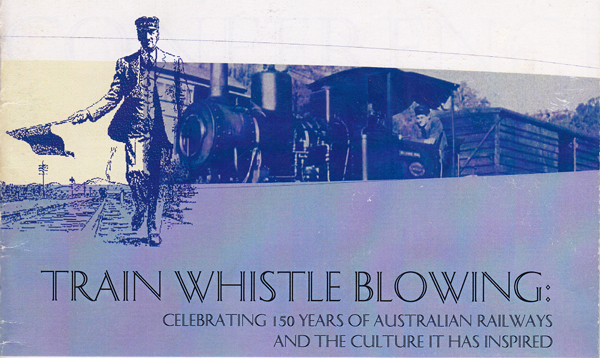Compiled and Edited by Andrew Piper and Brain Dunnett UNE 2005 [44 pages]
INTRODUCTION
This booklet of songs and poems has been prepared as a souvenir for the National Railway
Heritage Conference - Thinking Rail: Lessons from the Past, the Way of the Future, Tamworth,
28-30 September 2005. The conference was held as part of events associated with the 150th
anniversary of the beginning of steam railways in NSW and immediately preceded the official
opening of the Australian Railway Monument and Rail Journeys Museum, newly established
at Werris Creek Railway Station. The material chosen draws attention to the rich contribution
railways have made to Australian writing, music, photography, art and culture in general
When convict and horse drawn railways are taken into account the tradition of describing
railway events and the people associated with them through art and culture can be traced
back to the early part of the nineteenth-century. From the days when human-propelled railway
carriages served the convict establishment at Port Arthur in Tasmania and horse drawn railways
functioned at the mouth of the Murray River in South Australia, to the commencement of
steam railway operations in all Australian colonies, and though two depressions, general strikes,
the foundation of the Commonwealth of Australia, two world wars and changing technology,
railway workers and those who used the services of Australian Railways have reflected on the
moods of the times.
The value of these observations as a social record of Australia is considerable, coming as it
does from all sections of Australian society. These reflections provide an insight into issues that
continue to impact upon us today, such as the desire for sustainable transport.
As the first locomotive steamed out of the Cleveland Paddock, Sydney, on its way to Parramatta
in September 1855 it was joyfully sent on its way to the sound of a military brass band playing
the Sydney Railway Waltz. William Paling, who went on to found musical establishments
throughout Australia, had specially written this waltz for the occasion.
There are often many dimensions to an important historical event and this particular dance
composition was not the only musical entertainment on hand. The Sydney Morning Herald
of the day reported that the 'Navies: who played a major part in building the Parramatta
line, celebrated the fruits of their labour carousing (and no doubt singing) to the music of a
traditional folk band. At a time when photography was in its infancy several artists were also on
hand to paint and sketch the scene, contributing to a railway artistic tradition that continues
to this day.
This songbook is part of a broader project into Australian railway culture and is intended as a
foretaste of a substantial publication on the Australian Railway Story as seen through the eyes
of songwriters and poets. We reveal but a selection of the songs and illustrations associated
with Australian railways. It is a sample of the rich saga of Australian railways yet to be told. The
material has been selected to represent as much of the Australian Railway Story as possible
while keeping in mind the need for songs, music and poems that will keep the reader interested
and hopefully performing them.
The resonant observations of poets, writers, storytellers, songwriters and other artists inspired
by railways have made an important contribution to Australia's cultural development and our
collective memories of the past. Here we present a range of these for you to sing, recite and
play as you celebrate in various ways 150 years of Australian railways.
TERMS AND LANGUAGE
(Found in Australian Railway Songs and Poems)
Barracks - a resting facility (hostel) for drivers and crews in locations away from home depot.
A Bat - referred to the shovel used to get coal into the firebox.
Blowing off - was the noise associated with realising excess steam that built up in the boiler.
This was done through the locomotives safety valve if steam pressure got too high.
Bungs or please explain your action - a system of red tape and rules enforced by an army of
railway clerks.
Feeder - oil can grease lamp or oil lamp to see inside an axle box.
Fireworks - a display of hot sparks and flames that could be seen leaving the engines funnel
when working hard.
Pricker - was a long steel rod used to poke the fire and keep the coal burning in the firebox.
Raking the Ash - was a regular job to remove the coal ash that would not burn from the
firebox. This had to be done every fifty miles or so where a locomotive could be put over a
maintenance pit and a long rake could be used from beneath the locomotive in order to reach
all parts of the firebox.
She - used to refer to the locomotive.
Stamping - describes the locomotives wheel action of slipping or spinning.
Steaming Dull - Below full steam pressure the art of firing by a good fireman was to keep the
steam pressure high and constant.
Store - where driver's kits and oil are stored.
Swinging the (firebox) door - or closing it was a way of retaining a good fire while getting
another full shovel of coal.
Worn Tyres - wearing of the metal outer rim of the locomotives wheels causing poor wheel
grip and wheel spinning.
The Union - not necessary a trade union but a section of railway track where lines met.

No comments:
Post a Comment